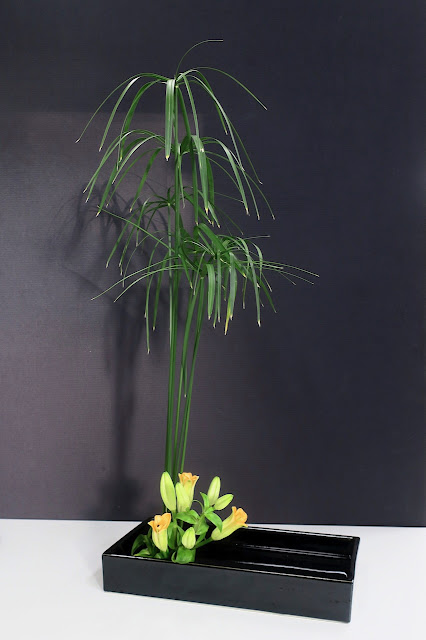Two weeks ago I had set my senior Geelong students the task of making an ikebana 'emphasising the surface of the water' in a suiban. Given that we were then just over 2/3 of the way through summer, it seemed like a cooling idea. As usual, and very pleasingly, the students' work showed a variety of expressions of the idea.
Tess created a loose ikebana using bamboo stems and a pink Statice, Limonium. The open ikebana felt like a light breeze was blowing.
Maureen set five stems of Umbrella grass, Cyperus alternifolius, and a small group of Asiatic lily buds in a black suiban, creating reflections on the surface.
Christine took a different approach by creating an abstract design with strong stems braced across the suiban. Small Crabapple, Malus, fruit were contained between two of the lines. A third line was added to break-up the larger space on the right side of the suiban.
Ellie's ikebana featured three green Lotus pods, Nelumbo nucifera, two variegated Aspidistra leaves and a small mass of Sedum. Her ikebana was set to the right edge of the circular suiban to allow the reflection of the material to be seen in the water surface.
Maree's exercise was to create an ikebana "Using both Fresh and Unconventional (man-made) materials". In a flat-sided glass vessel she arranged masses of black and unpainted wooden pegs. These were contrasted with a single line of Plumbago auriculata.
Jo's exercise was to take the 'unconventional material' idea one further step. That is, she was to make a purely sculptural work using only man-made materials. She used black rope-like oval shapes, that reminded me of quoits, which she massed into a tall irregular structure. To create a focal point she added a small mass of blue plastic ties and some blue bubble-wrap.
This is a challenging exercise to which students, consciously or not, bring lessons that they have learnt from their ikebana studies.
* * * * *
In the garden the pots of Hydrangeas have started to dry off. Their colours are fading and becoming more muted. I am hoping that some will survive into the autumn without being burnt by the sun. In that case, there is a good chance that they might develop rich red tones. I picked three small flower heads for my ikebana.
The colours in the flower heads are warm and muted. Some of the leaves are bright red at their tips and I wanted them to be seen also. However, this looks too busy...
...so I carefully removed two of the downward hanging leaves. This draws more attention to the the flower on the right and strengthens the asymmetry of the design. The botanical materials form the mass in this ikebana. In this instance the vase provides the line. The elegant six-sided Japanese vase has a very dark brown Temoku glaze.
Greetings from Christopher
17th February 2024






.jpeg)
.jpeg)
No comments:
Post a Comment